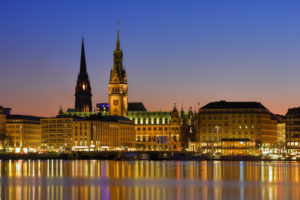Würzburg, located in the Franconia region of Bavaria, Germany, is steeped in culture and history. Here are the top cultural places to visit on vacation in Würzburg:
Würzburg Residence (Würzburger Residenz): A UNESCO World Heritage Site, the Würzburg Residence is one of the most magnificent palaces in Europe. Built in the 18th century, it is a masterpiece of Baroque architecture and houses stunning frescoes by the Venetian artist Giovanni Battista Tiepolo. The palace’s opulent interiors and beautiful gardens make it a must-visit cultural attraction.
Marienberg Fortress (Festung Marienberg): Perched on a hill overlooking the Main River, Marienberg Fortress offers panoramic views of Würzburg and its surroundings. This medieval fortress houses the Mainfränkisches Museum, which exhibits artifacts related to the history and culture of Franconia, making it an essential stop for history enthusiasts.
Würzburg Cathedral (Dom St. Kilian): Dedicated to Saint Kilian, Würzburg Cathedral is an architectural gem that combines elements of Romanesque, Gothic, and Baroque styles. Its awe-inspiring interior features intricate sculptures, stunning stained glass windows, and the tombs of numerous bishops and rulers, making it a must-see cultural landmark.
Käppele (Wallfahrtskirche Käppele): This charming Baroque pilgrimage church sits atop the Nikolausberg hill overlooking Würzburg. The Käppele is renowned for its beautiful frescoes, sculptures, and altars dedicated to the Virgin Mary. Visitors can climb the steps to the church to enjoy breathtaking views of the city below.
Julius Maximilian University of Würzburg (Julius-Maximilians-Universität Würzburg): Founded in 1402, the University of Würzburg is one of Germany’s oldest and most prestigious universities. Its historic campus features beautiful architecture, including the Neubaukirche (New Church) and the University Library, making it a cultural highlight of the city.
Stift Haug (Haug Abbey): This former Benedictine monastery, located in the heart of Würzburg, is now home to the Faculty of Catholic Theology at the University of Würzburg. The abbey’s Baroque church, library, and cloisters are open to visitors, offering insights into the region’s religious and cultural history.
Alte Mainbrücke (Old Main Bridge): Spanning the Main River, the Alte Mainbrücke is one of Würzburg’s most iconic landmarks. Adorned with statues of saints and historical figures, the bridge offers picturesque views of the city skyline and is a popular spot for leisurely walks and photography.
Grafeneckart (Grafeneckart Gallery): This contemporary art gallery showcases works by local and international artists, as well as rotating exhibitions and special events. Located in a historic building near the Würzburg Residence, Grafeneckart Gallery is a hub of artistic expression and creativity in the city.
Neumünster Collegiate Church (Neumünster Stiftskirche): Dating back to the 11th century, Neumünster Collegiate Church is one of Würzburg’s oldest churches. Its Romanesque architecture, medieval cloisters, and Gothic sculptures make it a cultural and architectural gem worth visiting.
Kulturspeicher Würzburg (Culture Warehouse): Housed in a historic grain storage facility along the Main River, Kulturspeicher Würzburg is a contemporary art museum that hosts exhibitions, performances, and cultural events. Its industrial-chic setting and diverse programming make it a unique cultural destination in Würzburg.
Franconia Fountain (Franconia Brunnen): Located in the heart of Würzburg’s Market Square (Marktplatz), the Franconia Fountain is a symbol of the region’s identity and culture. Admire the intricate sculptures and decorative elements that depict Franconian folklore, history, and traditions.
Juliusspital Wine Estate (Weingut Juliusspital): Explore the Juliusspital Wine Estate, one of Germany’s oldest charitable wine estates, founded in 1576. Take a guided tour of the historic winery, stroll through the vineyards, and sample award-winning Franconian wines in the estate’s tasting rooms.
Museum am Dom: Discover the art and history of Würzburg Cathedral at the Museum am Dom, located next to the cathedral. The museum’s exhibits include religious artifacts, liturgical objects, and artworks related to the cathedral’s architecture and significance as a religious landmark.
Falkenhaus (Falcon House): Marvel at the ornate facade of the Falkenhaus, a historic Renaissance building in Würzburg’s pedestrian zone. Admire the intricate stucco decorations, allegorical figures, and ornamental details that adorn the building’s exterior, which now houses shops and cafes.
Würzburg City Walks: Join a guided walking tour of Würzburg to explore the city’s cultural heritage and architectural landmarks. Choose from themed tours focusing on topics such as Baroque architecture, wine culture, or Jewish history, and discover hidden gems and local insights along the way.
Alter Kranen (Old Crane): Visit the Alter Kranen, a historic crane located on the banks of the Main River. Built in the 18th century, this timber-framed crane was used for loading and unloading cargo from riverboats and is now a symbol of Würzburg’s maritime history.
Kiliansbrunnen (Kilian’s Fountain): Admire the Kiliansbrunnen, a monumental fountain dedicated to Saint Kilian, the patron saint of Würzburg. Located in front of the Würzburg Cathedral, the fountain features a central statue of Saint Kilian surrounded by allegorical figures representing faith, wisdom, and justice.
Jewish Quarter (Judenviertel): Explore Würzburg’s Jewish Quarter, which preserves the history and heritage of the city’s Jewish community. Visit landmarks such as the Jewish cemetery, synagogue ruins, and Jewish Museum Würzburg to learn about the Jewish presence in Würzburg throughout history.
Mainfränkisches Museum in der Festung Marienberg: Dive into the cultural history of Franconia at the Mainfränkisches Museum in Marienberg Fortress. The museum’s exhibits cover a wide range of topics, including archaeology, folk art, craftsmanship, and everyday life in the region over the centuries.
Stadttheater Würzburg (Würzburg Municipal Theatre): Experience the performing arts at the Stadttheater Würzburg, a historic theater dating back to the 18th century. Attend opera, ballet, theater, and musical performances in the elegant surroundings of this cultural institution.
These cultural places offer a rich tapestry of history, art, and architecture for visitors to explore and enjoy during their vacation in Würzburg. Whether you’re interested in Baroque palaces, medieval fortresses, or contemporary art galleries, Würzburg has something to captivate every cultural enthusiast.




